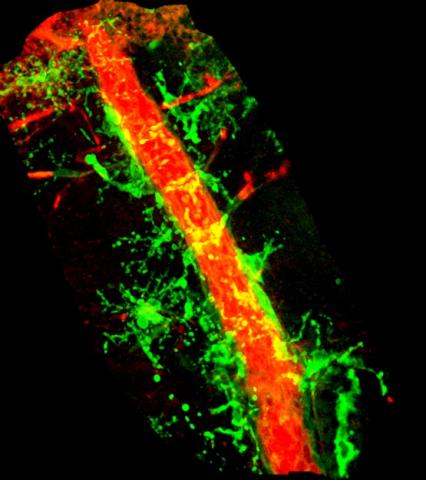Harvard Researchers Identify New Approach to Treating Wet AMD
Written By: BrightFocus Editorial Staff



Written By: BrightFocus Editorial Staff

What: Using a mouse model of wet age-related macular degeneration (AMD), Harvard researchers identified a potential treatment strategy to prevent and manage neovascular [wet] AMD by modulating the immune-vascular pathway.
Where: Wang T, et al. Myeloid Lineage Contributes to Pathological Choroidal Neovascularization Formation via SOCS3. EBioMed, October 21, 2021.
BrightFocus Connection: This research was supported by a 2019-22 BrightFocus Macular Degeneration Research (MDR) grant to Ye Sun, MD, PhD, the report’s corresponding author. She is an assistant professor, research associate, and instructor of ophthalmology at Harvard Medical School and and Boston Children’s Hospital (see link to grant profile below).
Why It Is Important: The development of abnormal blood vessels in the retina of the eye is the hallmark of wet AMD, the most common advanced form of the disease and the leading cause of vision loss in the elderly. New research shows how the immune system plays a key role in this process and identifies a new target for treating wet AMD.
Myeloid cells are young cells that develop into germ-fighting white blood cells, such as macrophages, which absorb and digest bacteria and cellular debris. During the development of wet AMD, these macrophages get recruited from general circulation into the eyes. There they release inflammation-producing cytokine molecules that stimulate abnormal blood vessel development, or neovascularization, in the retina.
Using mice whose retinas were treated with a laser to cause a condition that mimics wet AMD in humans, Harvard researchers explored the influence of a key mediator of inflammation, a gene known as SOCS3, on macrophages and inflammatory cytokine production. SOCS3 is an acronym for “suppressor of cytokine signaling 3.”
Subsequent laboratory analysis of eyes treated in this manner showed that the overexpression (ie, genetic over-production) of SOCS3 in myeloid-derived cells suppressed retinal neovascularization. The excess SOCS3 did so by suppressing the movement of macrophages and the secretion of inflammatory molecules into the retina. This was also confirmed using small molecules that mimic SOCS3.
This study opens the possibility to modulate immune-vascular crosstalk via SOCS3 as potential treatment to prevent abnormal vessel growth in wet AMD.
BrightFocus Foundation is a premier global nonprofit funder of research to defeat Alzheimer’s, macular degeneration, and glaucoma. Through its flagship research programs — Alzheimer’s Disease Research, Macular Degeneration Research, and National Glaucoma Research— the Foundation has awarded nearly $300 million in groundbreaking research funding over the past 51 years and shares the latest research findings, expert information, and resources to empower the millions impacted by these devastating diseases. Learn more at brightfocus.org.
Disclaimer: The information provided here is a public service of BrightFocus Foundation and is not intended to constitute medical advice. Please consult your physician for personalized medical, dietary, and/or exercise advice. Any medications or supplements should only be taken under medical supervision. BrightFocus Foundation does not endorse any medical products or therapies.
